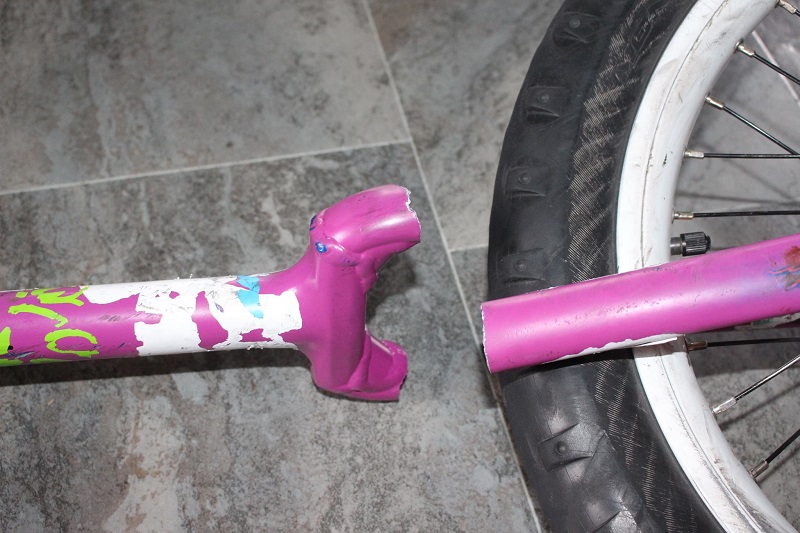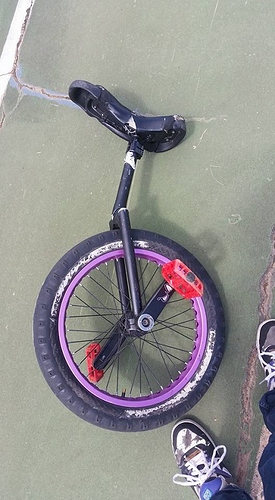SIF is the pure trials!!!
No hops is the pure-pure Trials!
Okay, let’s call that the pure Rolling Trials. Rolling has its limits…
I’m not sure if they are expensive right now, it’s more that they are almost impossible to find. No one produces them anymore, and the people that have one (like me) wouldn’t part with it. It’s more important for street and flat though, not that important for trials.
The only reasonable definition for pure (unicycle) trials is overcoming obstacles on a unicycle without putting your foot down, with no consideration to style or technique.
I have one on my 36 and it definitely will be mine until I can no longer ride any unicycle.
Compulsion has a curved carbon base, undrilled, for $100.
$100 for just a seat base is a bit much. Never done any work with carbon fibre but if it’s just layers of the stuff and epoxy I wonder how hard it’d be to diy one.
BTW I emailed Kris Holm about the neck length, here’s what he said:
This is good news because 200 mm seems like a happy middle ground. It seems the guys at UCD China got their facts wrong when they told me it was 150 mm, either that or they still have stock of the old 150 mm model.
I actually quite like the KH20, with the flat crown it probably makes a more versatile machine than the IG.
Here are a couple past threads on a DIY carbon fiber bases:
http://www.unicyclist.com/forums/showthread.php?t=109074
http://www.unicyclist.com/forums/showthread.php?t=95551&page=4&langid=5
Wow that’s pretty good, especially the second one. I’ll start off with an off-the-shelf saddle and maybe do one of these after.
I don’t know how he made the moulds, but it’s clear the results are better than using a vacuum bag.
The way I would do this:
[LIST=1]
I bet that’d cost more than just buying the $100 one! But it’d be a custom saddle. In China 3D printing services are reasonably inexpensive.
Anyway, I’ll add that to my stash of DIY projects.
Also not mentioned here the long neck KH’s neck bends like spaghetti. Mine curves forward and a rider I live with bent his to the side.
Here is the bent to the side one in all its glory…
Damn! Which year model is that? Has anyone experienced this problem with the lastest model?
That is the new model but the long neck. Now the neck is shorter. Whether there will be the same problems who knows.
This is a new model.
But it can happen with impacts also.
If you ride hard enough, even though that rider is only about 65kg, you can break the KH’s.
A rider who weighs 45kg broke his new KH like in that picture.
That’s crazy  It must have been some pretty extreme riding. The Impact Gravity frame looks like it might be a tad stronger, at the expense of no foot-on-crown tricks. I have no idea how the sides attach to the neck though, can’t see any welds.
It must have been some pretty extreme riding. The Impact Gravity frame looks like it might be a tad stronger, at the expense of no foot-on-crown tricks. I have no idea how the sides attach to the neck though, can’t see any welds.
The impact gravity and the mad4one are probably one of the stronger ones. They are an arch shape which probably helps. The new impact gravity actually has no welds as it is hydroformed. However it also has crappy 32mm bearings.
The IG is definitely welded, there’s no way to create a weld-free hollow ‘Y’ shape without using a casting process, which would result in a very weak part. In the case of the IG what they’ve done is first weld three sections of tube and then smoothed out the welds by sanding or CNC machining, thereby creating the illusion of a weld-free product. Other than the added aesthetic appeal, smooth welds may remove stress risers resulting in stronger joints.
Hydroforming is usually performed prior to welding, and its purpose is to shape straight tube into a funkier shape (see the sides of the Impact Gravity). Hydroformed frames are usually stronger and look sexier.
Can’t remember where but someone who was initially sceptical about these bearings used them for 6 months without a hitch. They are a bit wider than the usual uni bearings, so they either employ two rows of spherical bearings or one row of needle roller bearings (which would have much greater load capacity than much larger ball bearings). I suspect they are two-row ball bearings though.
Edit: It’s defo welded, according to UDC:
Notice how in the destruction photos the ruptures are right on the edges of the welds. Any sudden change in material thickness focuses the stress and that is where they break. Although a single impact can tear metal apart by simply exceeding its tensile strength, most failures are caused by fatigue.
This is why welds are either avoided by design or polished out in high quality gear. The Impact frame is on the right track with its curves.
A second problem, especially with aluminium, is the effect of heat. Heat treatment of the same metal alloy can double its strength. Then it is all lost by welding. Worse still, the change from the tempered alloy to the heat affected weld focuses the stress.
Aluminium is very susceptible to fatigue because no matter how small a stress is applied to the material, repeating it enough times will cause fatigue crack to develop. The smaller the stress the more repeats it will take, but things have a definite design life that can be calculated very accurately for well defined forces.
Compare this to steel which has what is called a “fatigue limit”. Below a certain level of stress it is not susceptible to fatigue and the stress may be applied an indefinite number of cycles. Similarly with titanium.
If you want a seriously strong, light robust frame then get a Triton titanium frame. You won’t see the welds on them either. Titanium also has the advantage being corrosion proof and polishing up like a precious metal. They aren’t cheap though and the standard seat tube in a Triton is very short.
However I do think you should just get a cheapie to start with and see if you actually like riding. You can always lend the cheapie to your friends instead of risking “the Rolls”.
They’re non-standard though, which is annoying if you want to be able to mix and match parts among your fleet or keep a common set of spares.
I don’t have a link but I read not two days ago on this forum that frames are treated after welding. Apparently frame manufacturers usually have big furnaces where they can bake a whole batch of frames in one go.
That is comforting news. Planes made of aluminium, right?
Sounds like a solid plan, and a good way to get people to “join the club”. I really think I’m going to get the cheaper Nimbus II.
Yeah that is pretty annoying. I was expecting these bearings to be an off-the-shelf product. After all, making decent ball bearings requires a lot of expertise and very expensive facilities. Most manufacturers buy bearings from a third party e.g. SFK, NSK, etc. I’ve bought bearings for my trials bike before off Taobao.com, just done a search and was able to find 42x22x12 (the ‘standard’ unicycle hub bearing), but indeed could not find any 32x22x12 ones. Do the bearings on a trials uni degrade that quickly?
Yes. Engineers do a lot of calculations and the parts are replaced on schedules.
I remember an episode of “Air Crash Investigation” where the repairers fitted two rows of rivets where there should have been three. The repair still handled thousands of pressurisation cycles until it failed catastrophically. Engineers calculated the expected life of the faulty repair and were out by twelve cycles from what actually happened.
They use titanium in critical parts and increasingly, carbon fibre parts glued together. I do hope it is very good glue.
My mistake about the welds. Though not a mistake about the 32mm bearings being rubbish. I know a 48kg 13 yr old who has broken 4 pairs of them. I know a good rider who is 68kg who destroyed them in 3 weeks of flatland. Any serious riding even for a light person will break them, and if you tighten the bearing holders too much (I suspect this may have been an issue with the 13 yr old) it also destroys them. When I say too much I mean the amount you need to tighten them to stop them coming undone when you don’t have Loctite. Loctite is a necessity of you want them to not come loose.
Doesn’t happen with 42s.
Udc Brought the size in using dual 32mm bearings to make up the width, those were rubbish so they ended up making double thickness single bearings, they are still almost as bad.



